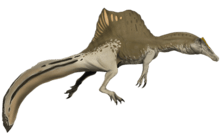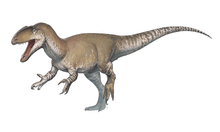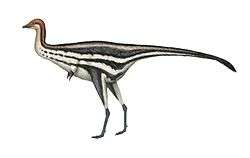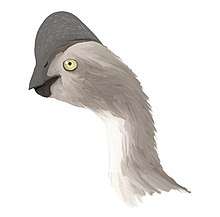Sciurumimus
Sciurumimus ("Squirrel-mimic," named for its tail's resemblance to that of the tree squirrel, Sciurus[1]) is an extinct genus of tetanuran theropod from the Late Jurassic of Germany. It is known from a single juvenile specimen representing the type species, Sciurumimus albersdoerferi, which was found in a limestone quarry close to Painten in Lower Bavaria.[2] The specimen was preserved with traces of feather-like filaments.[3]
| Sciurumimus | |
|---|---|
 | |
| The juvenile type specimen | |
| Scientific classification | |
| Kingdom: | Animalia |
| Phylum: | Chordata |
| Clade: | Dinosauria |
| Clade: | Saurischia |
| Clade: | Theropoda |
| Clade: | Tetanurae |
| Genus: | †Sciurumimus Rauhut et al., 2012 |
| Species: | †S. albersdoerferi |
| Binomial name | |
| †Sciurumimus albersdoerferi Rauhut et al., 2012 | |
The Sciurumimus specimen was first announced in 2011 in an informal presentation,[4] but not formally described and named until the following year. Although originally classified as a basal megalosauroid,[2] later phylogenetic analyses dispute this placement.[5]
Description

Sciurumimus is known from a single holotype fossil that is exceptionally well-preserved, with full skeleton in complete articulation along with fine details of soft tissue. It is comparable in size and proportions to the juvenile coelurosaur Juravenator, although differs significantly in several anatomical details. The skull of Sciurumimus is proportionally large, at 156% of the length of the femur and longer than the cervical vertebrae series. These body proportions, along with short forelimbs, lack of fusion in the skeleton, and regular tooth morphology indicate the specimen represents a very young, probably early-posthatchling individual.[2]
The fossil preserves filamentous plumage at the tail base and on other parts of the body. These structures are described as being identical to the stage 1 feathers preserved in some ornithischians, the basal tyrannosaur Dilong, and the basal therizinosauroid Beipiaosaurus. Although most of the preserved soft tissue on the Sciurumimus holotype likely represent integumentary structures, a small patch of what may be muscle tissue is observed along the rear edge of the tibia.[2]
Classification

When first discovered, a phylogenetic analysis suggested that Sciurumimus may have been a primitive member of the Megalosauroidea, a clade of large carnivorous dinosaurs more primitive than many other well-known theropods like the tyrannosauroids and carnosaurs, making it the most basal known feathered theropod.[2] This classification was supported by one of three initial analyses conducted by the scientists who described it. The other two analysis, which the authors regarded as less well supported, found it as more closely related to Monolophosaurus and Avetheropoda, and in an unresolved position among avetheropods and megalosauroids, respectively. The exact position in the various analyses was difficult to determine due to the fact that the only known specimen is a very young juvenile.[2]
This initial study was criticized by several researchers, who noted that some of the old analysis the scientists used to plug in data from the new fossil were incomplete and missing relevant data on various species.[6][7] In an analysis published in 2013 Sciurumimus was obtained as one of the most primitive members of the Coelurosauria, more derived than the megalosauroids. However, this analysis focused on the Coelurosauria and the dataset on which it was based contained only one megalosaurid and only four terminal taxa outside the Coelurosauria.[8] Other analyses found it to be an allosauroid[9] or a tetanuran outside Avetheropoda.[10] Paul (2016) placed it among basal neocoelurosaurs.[11] A detailed reanalysis of the taxon was done in the supplementary material of Hartman et al (2019) which found several characters to be misscored, and when the uncorrected Sciurumimus was placed in the matrix Juravenator was also found to be a basal tetanuran, while if Sciurumimus was absent Juravenator would be found to be a basal coelurosaur. The analysis found Sciurumimus to be a compsognathid, though they noted that this position was tentative.[12]
References
- "Newly Discovered Dinosaur Implies Greater Prevalence of Feathers". American Museum of Natural History. July 2, 2012. Retrieved February 2, 2019.
- Rauhut, O. W. M.; Foth, C.; Tischlinger, H.; Norell, M. A. (2012). "Exceptionally preserved juvenile megalosauroid theropod dinosaur with filamentous integument from the Late Jurassic of Germany". Proceedings of the National Academy of Sciences. 109 (29): 11746–11751. Bibcode:2012PNAS..10911746R. doi:10.1073/pnas.1203238109. PMC 3406838. PMID 22753486.
- Switek, B. (2012). "Rise of the fuzzy dinosaurs". Nature. doi:10.1038/nature.2012.10933.
- Rauhut and Foth, 2011. New information on Late Jurassic theropod dinosaurs from Southern Germany. IV Congresso Latinoamericano Paleontologia de Vertebrados.
- "GEOL 104 Theropoda I: Dinosaurs Red in Tooth and Claw". www.geol.umd.edu. Retrieved 2019-07-24.
- Mortimer, M. 2013. "Coelurosauria Archived 2013-09-29 at the Wayback Machine", The Theropod Database. Accessed online 09-AUG-2013.http://archosaur.us/theropoddatabase/Coelurosauria.htm#Sciurumimusalbersdoerferi
- Mortimer, M. and Marjanovic, D. (in prep.) http://archosaur.us/theropoddatabase/Coelurosauria.htm#Sciurumimusalbersdoerferi Archived 2013-09-29 at the Wayback Machine
- See pages 3 and 11 in the supplementary material of Godefroit, Pascal; Cau, Andrea; Hu, Dong-Yu; Escuillié, François; Wu, Wenhao; Dyke, Gareth (2013). "A Jurassic avialan dinosaur from China resolves the early phylogenetic history of birds". Nature. 498 (7454): 359–362. Bibcode:2013Natur.498..359G. doi:10.1038/nature12168. PMID 23719374.
- Yang, Zixiao; Jiang, Baoyu; McNamara, Maria E.; Kearns, Stuart L.; Pittman, Michael; Kaye, Thomas G.; Orr, Patrick J.; Xu, Xing; Benton, Michael J. (January 2019). "Pterosaur integumentary structures with complex feather-like branching". Nature Ecology & Evolution. 3 (1): 24–30. doi:10.1038/s41559-018-0728-7. ISSN 2397-334X.
- Benton, Michael J.; Dhouailly, Danielle; Jiang, Baoyu; McNamara, Maria (2019-09-01). "The Early Origin of Feathers". Trends in Ecology & Evolution. 34 (9): 856–869. doi:10.1016/j.tree.2019.04.018. ISSN 0169-5347.
- Paul, Gregory S. (2016). The Princeton Field Guide to Dinosaurs 2nd Edition. Princeton University Press. p. 120. ISBN 978-0-691-16766-4.
- Hartman, Scott; Mortimer, Mickey; Wahl, William R.; Lomax, Dean R.; Lippincott, Jessica; Lovelace, David M. (2019-07-10). "A new paravian dinosaur from the Late Jurassic of North America supports a late acquisition of avian flight (Supplemental phylogenetic data)". PeerJ. 7: e7247. doi:10.7717/peerj.7247/supp-1. ISSN 2167-8359. PMC 6626525. PMID 31333906.














